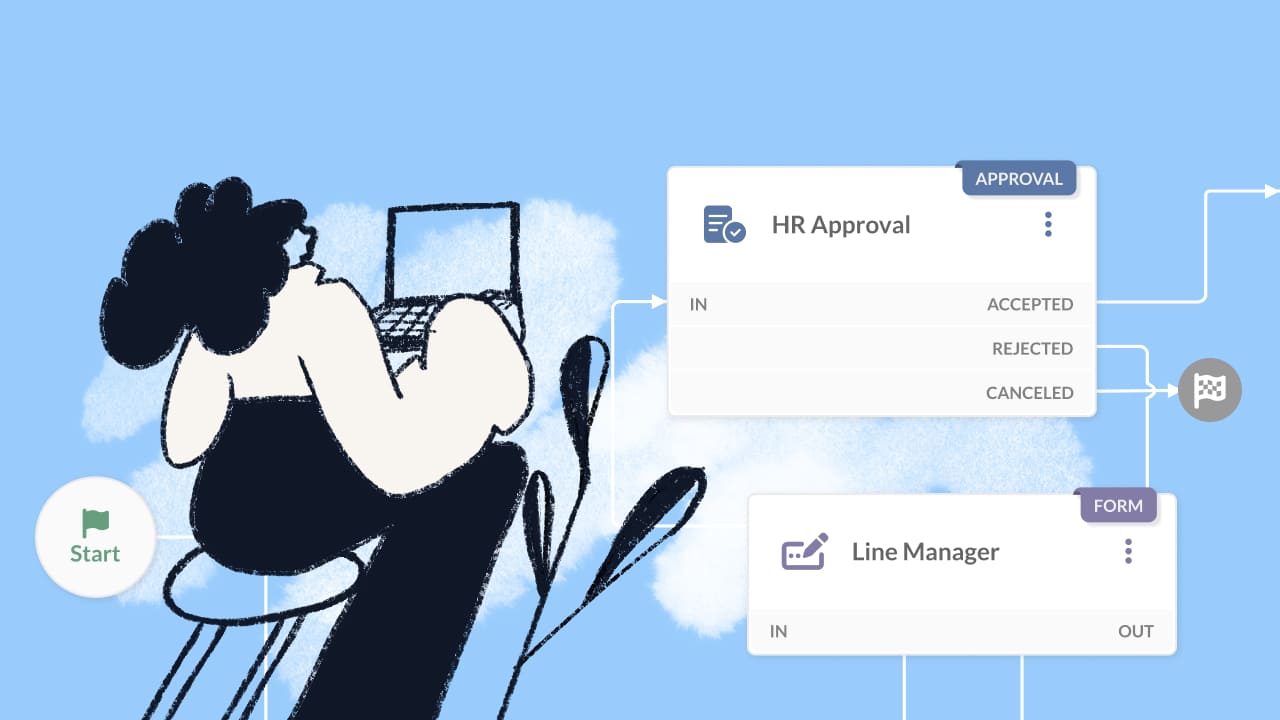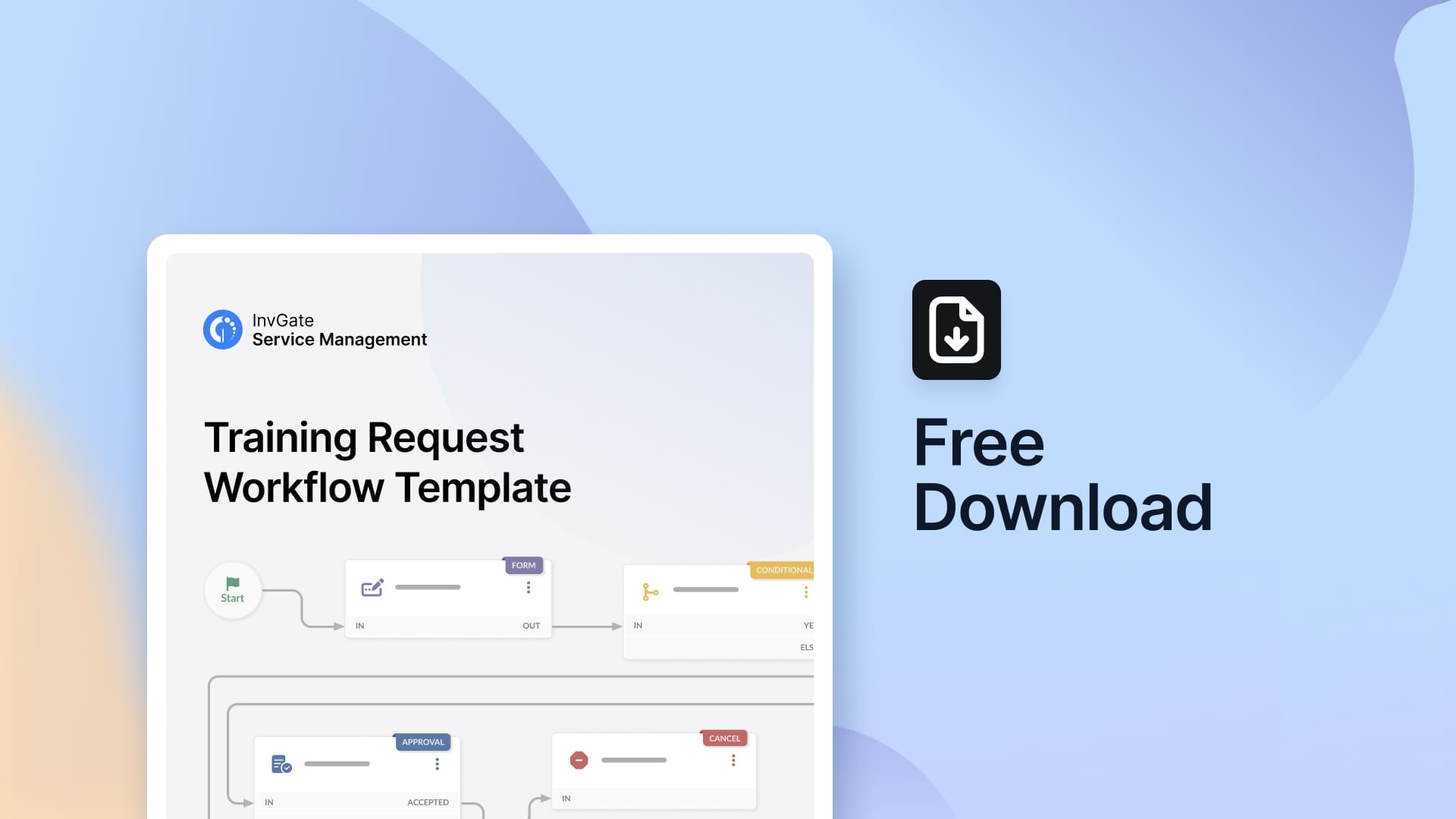ITSM workflows play a major role in structuring and automating Service Management. Organizations looking to improve efficiency and accuracy are turning to automation to minimize repetitive work. According to the Service Desk Institute, employees in organizations using automation believe they can handle 30% more work due to these efficiency gains.
Automating ITSM workflows helps IT teams reduce errors, standardize processes, and improve response times.
This article covers key workflows that benefit from automation, how to implement them, and best practices to optimize performance.
What is an ITSM workflow?
ITSM workflows define how tasks move through structured processes, assigning responsibilities and tracking progress. They standardize Service Management, reducing inconsistencies and improving accountability.
It clarifies who is responsible, what information is needed, and which actions must happen at each stage. The goal is to give teams a structured way to manage work so requests don’t stall, approvals happen at the right moment, and updates reach the people who need them.
Organizations use workflows for common processes such as incident handling, service requests, Change Management, problem investigations, and more. Each workflow can include forms, routing rules, automated actions, and communication checkpoints, depending on the process and the level of detail required.
What are the benefits of ITSM workflows?
Clear workflows help teams organize their work and improve consistency across departments. People know what to do next, which reduces delays and avoids steps being skipped. They also support better visibility because managers can see how tasks progress and where bottlenecks appear.
Another advantage is standardization. When teams follow the same structure, your service delivery becomes more predictable and easier to improve. It also helps reduce manual effort by allowing automation to handle repetitive actions such as routing, notifications, or approvals.
Teams also benefit from having clear communication paths. Requesters receive timely updates, support agents understand context, and stakeholders can track progress without relying on extra messages or meetings.
Without automation, IT teams spend a lot of time manually approving requests, tracking asset assignments, and managing service changes. Automated workflows handle these processes efficiently, freeing IT staff to focus on more complex tasks. Workflows become especially useful as organizations grow, since they help keep processes steady even when volume increases or responsibilities shift.
4 common ITSM workflow mistakes to avoid
Teams often run into a few recurring issues when building or maintaining their ITSM workflows. Four of the most frequent ones include:
- Unclear or incomplete workflow design.
- Documentation that doesn’t match the actual process.
- Weak ownership of the workflow once it goes live.
- Governance practices that fade over time.
Design and documentation issues in ITSM workflows
Trouble often begins when the workflow’s structure isn’t fully defined. Extra steps pile up, approval chains grow longer than needed, or key rules never make it into the documentation. Agents then interpret the process in different ways, which leads to inconsistent handling and delays.
You can reduce these problems by:
- Defining the workflow’s purpose, required inputs, roles, and expected outputs.
- Documenting the steps in a way that matches daily work.
- Showing how the workflow connects with related processes.
- Reviewing documentation after changes or process updates.
Execution, ownership, and governance gaps
Strong design won’t hold if no one keeps the workflow current. Over time, teams introduce workarounds, skip steps, or adjust tasks informally because no one is overseeing the process. Without ownership, the workflow slowly drifts away from its intended use.
You can prevent drift by:
- Assigning a clear process owner.
- Tracking workflow performance and updating steps when needs evolve.
- Reviewing rules and approval paths during governance meetings.
- Checking for outdated tasks or manual work that could be automated.
Key ITSM workflows you should automate
Automating ITSM workflows allows teams to manage common IT requests efficiently. The following examples highlight processes that benefit from automation, how they work, and why they are valuable.
Core ITSM workflows
1. Change Request
Change request workflows ensure modifications to systems or processes are evaluated and implemented safely. This structured approach prevents uncontrolled changes that could disrupt services or create security risks.
The workflow typically includes:
- The requester submits change details and business justification
- Technical assessment of impact and requirements
- Stakeholder review and approval
- Implementation planning and scheduling
2. Release Management
Software releases require careful coordination across development, testing, and operations teams.
The Release Management workflow typically moves through:
- Development completion and initial testing
- Quality assurance review
- Stakeholder validation
- Deployment planning and scheduling
- Implementation and verification
Teams need to maintain quality standards while keeping releases moving forward. That's why a workflow is a great way to manage the progression through test environments while coordinating stakeholder approvals and scheduling.
Cross-department workflows
1. Employee onboarding and offboarding
Employee transitions require a coordinated effort across multiple departments. The employee onboarding workflow orchestrates everything from system access to equipment provisioning. Starting with HR's initial trigger, it can coordinate:
- Account creations
- Equipment setup
- Access permissions
- Training schedules
The flow is reversed for offboarding employees, ensuring all access is revoked and assets are recovered systematically. This structured handoff between departments prevents delays and security gaps while providing a consistent experience.
2. Training Request
Employees requesting training sessions need approvals and scheduling. A workflow manages how employees request and receive professional development opportunities.
The process ensures proper evaluation and resource allocation and can be used in many cases: technical certifications, skill development, or compliance training.
The training request workflow can move through:
- Employee submits a request with course details, costs, and business justification
- Management reviews it
- Budget verification and financial approval
- Training coordination and scheduling
- Completion tracking and documentation
3. Asset loans
Equipment loans need tracking to maintain availability and accountability. The asset loan workflow manages requests, approvals, and returns while tracking asset status and location.
It can include:
- Request submission with the business need
- Availability check and approval
- Asset assignment and documentation
- Usage tracking and deadline monitoring
This workflow coordinates between requesters, approvers, and IT teams. It can also keep an audit trail of the custody chain for compliance purposes.
4. Software requests
Managing software licenses requires approvals and compliance checks. With a workflow, you can manage the distribution of software licenses and applications while maintaining security and compliance requirements.
Some of the steps for a software request workflow are:
- The user submits a request
- License availability verification
- Management and security approval
- Installation scheduling / User provisioning for SaaS
- Deployment and confirmation
5. Documentation workflows
Documentation workflows ensure organizational knowledge remains accurate, accessible, and valuable. The process can begin either when a user identifies a gap requiring new documentation or when existing content needs updating due to changes or periodic reviews.
From there, it can follow the next steps:
- Expert assignment and content development
- Content review
- Feedback loops if the article needs changes
- Approval and publication
How to design and maintain an effective ITSM workflow
A strong ITSM workflow starts with a clear understanding of the process, the people involved, and the outcome you want to support. Once the structure is in place, the workflow needs regular review so it stays aligned with current service needs, avoids unnecessary steps, and reflects the way teams actually work.
How to create an ITSM workflow step by step
Let's look at how to build a really solid ITSM workflow with these eight steps.
- Make sure that the process you’re designing the workflow for is well-documented and up to date, and that you understand all the steps and transfer points. It sounds simple, we know, but if there’s confusion around the end-to-end process, it’s much easier to fix it when you’re at the planning stage instead of trying to fix it retrospectively once you’ve committed it to your ITSM tool.
- Define your dependencies. Document your workflow to ensure that all the appropriate resources and capabilities are captured so that it works effectively and correctly.
- Define your start, end, and transfer points. Which activities or tasks will initiate your workflow? How will you know when the right outcome has been reached? How will your workflow manage handoffs to other process flows?
- Map out all tasks and put them in order. Before you go anywhere near your ITSM tool, map out your workflow step-by-step to ensure it consists of a logical series of structured activities. We've already reviewed some example tasks. Identify the order in which your steps need to be carried out. Does everything need to be done in sequence, or can some tasks be done at the same time?
- Identify task roles and owners. Some steps will be automated, but some will need human intervention. For example, escalating an incident after a complaint from the business or seeking a change exception during a freeze period.
- Validate supporting data and rules before building. Confirm that categories, forms, fields, SLAs, routing rules, and approval criteria already exist — or create them if they don’t. Strong supporting data prevents broken logic once the workflow goes live.
- Review and test the new workflow. Have you captured all the trigger points? Does everyone understand their role and the activities they’re expected to carry out? Are the right outcomes being accomplished?
- Review the new workflow again regularly. Work with the process owner. Schedule reviews so you can adapt to changes in business needs and respond to any feedback or identified improvements.
How to optimize ITSM workflows with automation, AI, and KPIs
Once a workflow is stable, the next step is to reduce repetitive work, speed up routine decisions, and measure performance so you can adjust the process over time. A balanced mix of automation, AI, and KPIs helps you do that.
Here are some practical ways to optimize your workflows:
Automation:
Use automation for predictable steps that don’t need human decision-making.
- Route tickets to the right group based on category, CI, or request details.
- Trigger notifications, reminders, and escalations to keep work moving.
- Auto-approve low-risk, well-defined requests using rule-based conditions.
- Update related records, such as CI ownership, asset data, or linked requests.
AI:
AI helps speed up triage and reduce manual classification.
- Categorize and route requests based on text analysis.
- Suggest relevant knowledge articles for agents and end-users.
- Summarize long ticket threads to enable faster handoffs.
KPIs:
Track performance so you can spot delays, validate improvements, and refine the workflow.
- Measure resolution time, FCR, and SLA compliance.
- Monitor automation rates to see where manual work still dominates.
- Review the touch count to understand how many interactions a process requires.
- Check backlog aging to identify slow steps or overloaded teams.
Finally, focus on continuous improvement. You can use the data you gather to update rules, remove unnecessary steps, and adjust forms or approvals. Small improvements applied consistently help keep the workflow effective as your service needs evolve.
Conclusion
Automating ITSM workflows with the right software reduces repetitive tasks, minimizes errors, and keeps service delivery consistent. Instead of relying on manual processes that slow things down, IT teams can use automation to standardize operations, track progress, and ensure nothing gets overlooked.
An ITSM platform makes this easier by providing the tools to design, monitor, and refine workflows as business needs evolve.
InvGate Service Management’s no-code workflow builder allows you to create and customize workflows without technical complexity. Anyone can tailor processes to fit your organization’s requirements! Want to see how it works? Sign up for a 30-day free trial.

























